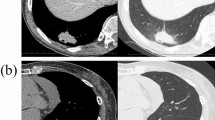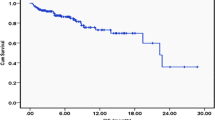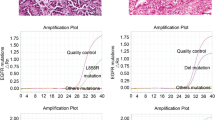Abstract
Purpose
Although many studies have explored clinicopathologic characteristics and prognosis of lung adenocarcinoma, a few literatures reported the mutational status of lung adenocarcinomas with lepidic pattern and whether there is difference between adenocarcinomas with pure lepidic component and lepidic predominant adenocarcinomas remain unknown.
Methods
One hundred and thirty-three patients including 92 adenocarcinomas with pure lepidic component and 41 lepidic predominant adenocarcinomas were subjected to the study. All the clinicopathologic data, the follow-up information and the status of gene mutations including EGFR, KRAS, HER2, BRAF, AKT1, ALK, RET and ROS1 were investigated.
Results
Of the 133 lung adenocarcinomas with lepidic pattern, 87.22 % (116/133) were detected harboring mutations in our tested genes, among which 90.52 % (105/116) harbored EGFR mutation. There are three KRAS mutations and two BRAF mutations in our cohort, and we revealed two ALK fusion and one RET fusion. No ROS1 fusion was discovered. There was no significant difference in gene mutations between adenocarcinomas with pure lepidic component and lepidic predominant adenocarcinomas except EGFR mutation (p = 0.039). Lepidic predominant adenocarcinomas seemed to have more EGFR mutation. The post-recurrence survival was significantly prolonged in patients who received TKIs.
Conclusions
Adenocarcinoma with lepidic pattern is a low-grade lung tumor with favorable prognosis and displays frequent EGFR mutation. Compared with lepidic predominant adenocarcinomas, lung adenocarcinomas with pure lepidic component have a better prognosis. On the basis of these results, we also suggested the application of EGFR-TKIs therapy for EGFR mutation-positive patients after recurrence could achieve prolonged survival.



Similar content being viewed by others
References
Azzoli CG, Baker S, Temin S, Pao W, Aliff T, Brahmer J et al (2009) American Society of Clinical Oncology clinical practice guideline update on chemotherapy for stage IV non–small-cell lung cancer. J Clin Oncol 27(36):6251–6266
Borczuk AC, Qian F, Kazeros A, Eleazar J, Assaad A, Sonett JR et al (2009) Invasive size is an independent predictor of survival in pulmonary adenocarcinoma. Am J Surg Pathol 33(3):462
Edge S, Byrd DR, Compton CC, Fritz AG, Greene FL, Trotti A (2010) AJCC cancer staging manual, 7th edn. Springer, New York
Gu J, Lu C, Guo J, Chen L, Chu Y, Ji Y et al (2013) Prognostic significance of the IASLC/ATS/ERS classification in Chinese patients—a single institution retrospective study of 292 lung adenocarcinoma. J Surg Oncol 107(5):474–480
Herbst RS, Heymach JV, Lippman SM (2008) Lung cancer. N Engl J Med 359:1367–1380
Kadota K, Villena-Vargas J, Yoshizawa A, Motoi N, Sima CS, Riely GJ et al (2014) Prognostic significance of adenocarcinoma in situ, minimally invasive adenocarcinoma, and nonmucinous lepidic predominant invasive adenocarcinoma of the lung in patients with stage I disease. Am J Surg Pathol 38(4):448
Lynch TJ, Bell DW, Sordella R, Gurubhagavatula S, Okimoto RA, Brannigan BW et al (2004) Activating mutations in the epidermal growth factor receptor underlying responsiveness of non–small-cell lung cancer to gefitinib. N Engl J Med 350(21):2129–2139
Marchetti A, Martella C, Felicioni L, Barassi F, Salvatore S, Chella A et al (2005) EGFR mutations in non–small-cell lung cancer: analysis of a large series of cases and development of a rapid and sensitive method for diagnostic screening with potential implications on pharmacologic treatment. J Clin Oncol 23(4):857–865
Mok T, Wu YI, Thongprasert S, Yang C, Chu D, Saijo N (2009) Initial treatment of pulmonary adenocarcinoma with gefitinib or carboplatin/paclitaxel. N Engl J Med 361:947–957
Nakagiri T, Sawabata N, Morii E, Inoue M, Shintani Y, Funaki S et al (2014) Evaluation of the new IASLC/ATS/ERS proposed classification of adenocarcinoma based on lepidic pattern in patients with pathological stage IA pulmonary adenocarcinoma. Gen Thorac Cardiovasc Surg 62(11):671–677
Noguchi M, Morikawa A, Kawasaki M, Matsuno Y, Yamada T, Hirohashi S et al (1995) Small adenocarcinoma of the lung. Histologic characteristics and prognosis[J]. Cancer 75(12):2844–2852
Paez JG, Jänne PA, Lee JC, Tracy S, Greulich H, Gabriel S et al (2004) EGFR mutations in lung cancer: correlation with clinical response to gefitinib therapy. Science 304(5676):1497–1500
Pan Y, Zhang Y, Li Y, Hu H, Wang L, Li H, Wang R, Ye T, Luo X, Zhang Y, Li B, Cai D, Shen L et al (2014) ALK, ROS1 and RET fusions in 1139 lung adenocarcinomas: a comprehensive study of common and fusion pattern-specific clinicopathologic, histologic and cytologic features. Lung Cancer 84(2):121–126
Russell PA, Wainer Z, Wright GM, Daniels M, Conron M, Williams RA (2011) Does lung adenocarcinoma subtype predict patient survival?: a clinicopathologic study based on the new International Association for the Study of Lung Cancer/American Thoracic Society/European Respiratory Society international multidisciplinary lung adenocarcinoma classification. J Thorac Oncol 6(9):1496–1504
Sakurai H, Dobashi Y, Mizutani E, Matsubara H, Suzuki S, Takano K et al (2004) Bronchioloalveolar carcinoma of the lung 3 centimeters or less in diameter: a prognostic assessment. Ann Thorac Surg 78(5):1728–1733
Sasada S, Miyata Y, Mimae T, Mimura T, Okada M (2015) Impact of Lepidic Component Occupancy on Effects of Adjuvant Chemotherapy for Lung Adenocarcinoma. Ann Thorac Surg 100(6):2079–2086
Shigematsu H, Lin L, Takahashi T, Nomura M, Suzuki M, Wistuba II et al (2005) Clinical and biological features associated with epidermal growth factor receptor gene mutations in lung cancers. J Natl Cancer Inst 97(5):339–346
Siegel RL, Miller KD, Jemal A (2015) Cancer statistics. CA Cancer J Clin 65(1):5–29
Strand TE, Rostad H, Strøm EH, Hasleton P (2015) The percentage of lepidic growth is an independent prognostic factor in invasive adenocarcinoma of the lung. Diagn Pathol 10(1):1
Travis WD, Brambilla E, Noguchi M, Nicholson AG, Geisinger KR, Yatabe Y, Yankelewitz D (2011) IASLC/ATS/ERS International multidisciplinary classification of lung adenocarcinoma. J Thorac Oncol 6(2):244–285
Travis WD, Brambilla E, Nicholson AG, Yatabe Y, Austin JH, Beasley MB, Chirieac LR, Dacic S, Duhiq E, Flieder DB, Geisinger K, Hirsch FR, Ishikawa Y et al (2015) The 2015 World Health Organization classification of lung tumors: impact of genetic, clinical and radiologic advances since the 2004 classification. J Thorac Oncol 10(9):1243–1260
Tsuta K, Kawago M, Inoue E, Yoshida A, Takahashi F, Sakurai H et al (2013) The utility of the proposed IASLC/ATS/ERS lung adenocarcinoma subtypes for disease prognosis and correlation of driver gene alterations. Lung Cancer 81(3):371–376
Vazquez M, Carter D, Brambilla E, Gazdar A, Noguchi M, Travis WD et al (2009) Solitary and multiple resected adenocarcinomas after CT screening for lung cancer: histopathologic features and their prognostic implications. Lung Cancer 64(2):148–154
Wang R, Pan Y, Li C, Hu H, Zhang Y, Li H, Luo X, Zhang J, Fang Z, Li Y, Shen L, Ji H, Garfield D et al (2012) The use of quantitative real-time reverse transcriptase PCR for 5′ and 3′ portions of ALK transcripts to detect ALK rearrangements in lung cancers. Clin Cancer Res 18(17):4725–4732
Warth A, Muley T, Meister M, Stenzinger A, Thomas M, Schirmacher P et al (2012) The novel histologic International Association for the Study of Lung Cancer/American Thoracic Society/European Respiratory Society classification system of lung adenocarcinoma is a stage-independent predictor of survival. J Clin Oncol JCO 2011 37:2185
Weichert W, Warth A (2014) Early lung cancer with lepidic pattern: adenocarcinoma in situ, minimally invasive adenocarcinoma, and lepidic predominant adenocarcinoma. Cur Opin Pulm Med 20(4):309–316
Yanagawa N, Shiono S, Abiko M, Ogata SY, Sato T, Tamura G (2013) New IASLC/ATS/ERS classification and invasive tumor size are predictive of disease recurrence in stage I lung adenocarcinoma. J Thorac Oncol 8(5):612–618
Yanagawa N, Shiono S, Abiko M, Ogata SY, Sato T, Tamura G (2014) The correlation of the International Association for the Study of Lung Cancer (IASLC)/American Thoracic Society (ATS)/European Respiratory Society (ERS) classification with prognosis and EGFR mutation in lung adenocarcinoma. Ann Thorac Surg 98(2):453–458
Yim J, Zhu LC, Chiriboga L, Watson HN, Goldberg JD, Moreira AL (2007) Histologic features are important prognostic indicators in early stages lung adenocarcinomas. Mod Pathol 20(2):233–241
Yoshizawa A, Motoi N, Riely GJ, Sima CS, Gerald WL, Kris MG et al (2011) Impact of proposed IASLC/ATS/ERS classification of lung adenocarcinoma: prognostic subgroups and implications for further revision of staging based on analysis of 514 stage I cases. Mod Pathol 24(5):653–664
Zhang J, Wu J, Tan Q, Zhu L, Gao W (2013) Why do pathological stage IA lung adenocarcinomas vary from prognosis?: a clinicopathologic study of 176 patients with pathological stage IA lung adenocarcinoma based on the IASLC/ATS/ERS classification. J Thorac Oncol 8(9):1196–1202
Funding
This study was funded by Tongren Hospital Fund (TR201416) and Shanghai Municipal Science and Technology Commission medical guide project (124119b1900).
Author information
Authors and Affiliations
Corresponding author
Ethics declarations
Conflict of interest
The authors declare that there is no conflict of interest that could be perceived as prejudicing the impartiality of the research reported.
Ethical approval
All procedures performed in studies involving human participants were in accordance with the ethical standards of the institutional and/or national research committee and with the 1964 Helsinki Declaration and its later amendments or comparable ethical standards.
Informed consent
Informed consent was obtained from all individual participants included in the study.
Rights and permissions
About this article
Cite this article
Xu, Y., Zhu, C., Qian, W. et al. Comprehensive study of mutational and clinicopathologic characteristics of adenocarcinoma with lepidic pattern in surgical resected lung adenocarcinoma. J Cancer Res Clin Oncol 143, 181–186 (2017). https://doi.org/10.1007/s00432-016-2255-8
Received:
Accepted:
Published:
Issue Date:
DOI: https://doi.org/10.1007/s00432-016-2255-8




